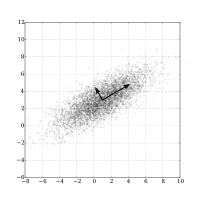
Photo from wikipedia
Background The diagnostic efficacy of mono- and bi-exponential diffusion models are controversial in prostate cancer (PCa) aggressiveness evaluation. Whole-tumor histogram analysis may have the potential to improve their efficacy. Purpose… Click to show full abstract
Background The diagnostic efficacy of mono- and bi-exponential diffusion models are controversial in prostate cancer (PCa) aggressiveness evaluation. Whole-tumor histogram analysis may have the potential to improve their efficacy. Purpose To compare the efficacy of mono- and bi-exponential diffusion models for evaluating PCa aggressiveness using whole-tumor histogram analysis. Material and Methods In this retrospective study, 72 patients with PCa confirmed by radical prostatectomy were included. All patients underwent multi-b-value diffusion-weighted imaging (DWI). The mono-exponential model parameter (apparent diffusion coefficient [ADC]) and bi-exponential model parameters (D, D*, and f ) were calculated and whole-tumor histogram analysis was performed. Tumor lesions were classified into low-grade (LG) and high-grade (HG) Gleason grade groups. Spearman analysis was used to evaluate the correlations between the histogram metrics and Gleason score (GS). The area under the receiver operating characteristic curve (AUC) was used to assess the discriminatory capacity of each parameter in distinguishing LG from HG PCa. Results Most histogram metrics of ADC and D showed significant correlations with the GS. None of the histogram metrics of D* and only the maximum value and skewness of f showed significant correlations with GS. The 90th percentile ADC and 90th and 75th percentile D showed relatively higher efficacies than other histogram metrics. However, their AUCs were not significantly higher than that of mean ADC. Conclusion The bi-exponential model was not superior to the mono-exponential diffusion model for evaluating PCa aggressiveness. The histogram metrics did not outperform the conventional mean value.
Journal Title: Acta Radiologica
Year Published: 2019
Link to full text (if available)
Share on Social Media: Sign Up to like & get
recommendations!